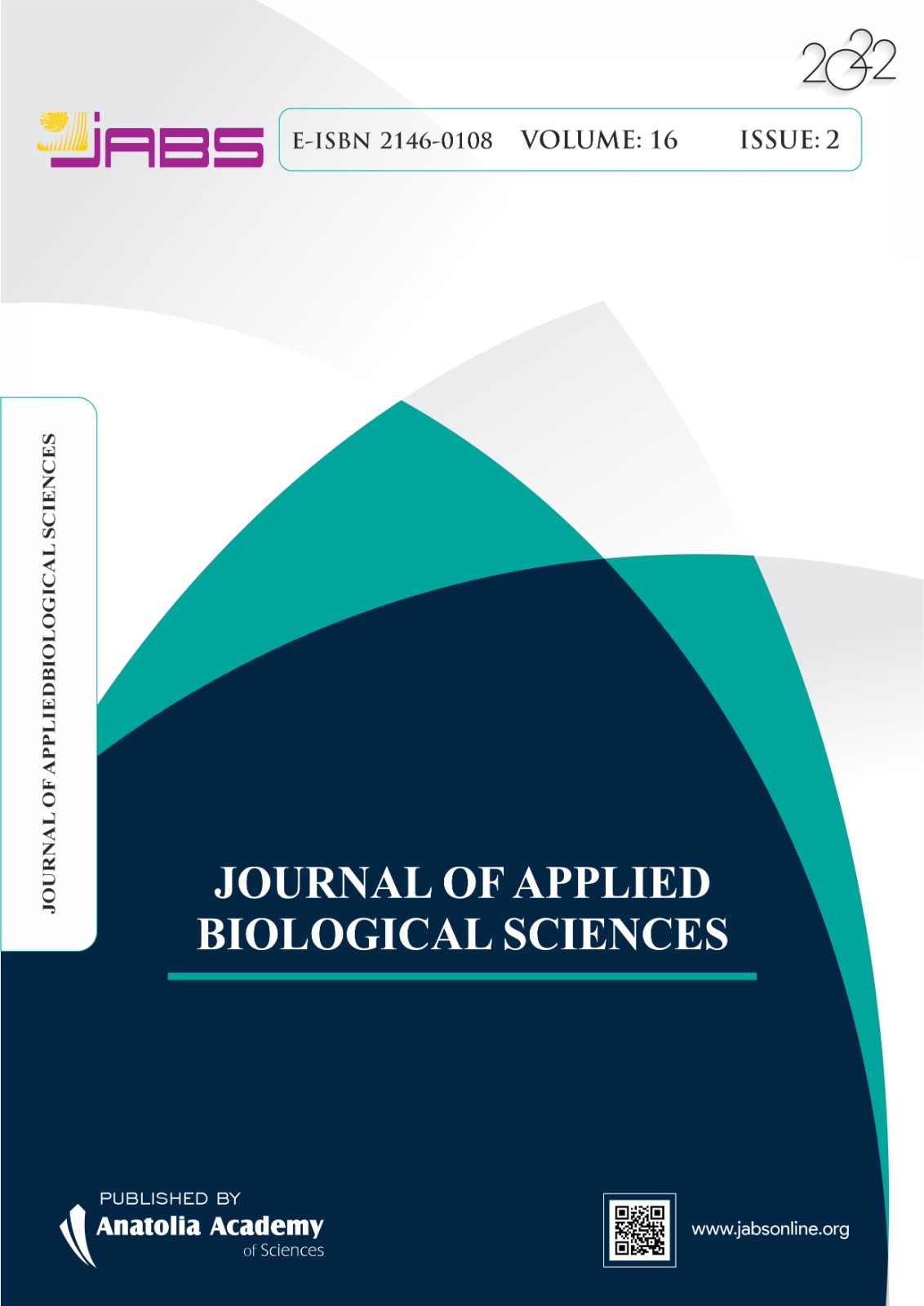INVESTIGATION OF SYNERGISTIC EFFECT OF GELDANAMYCIN AND CUCURBITACIN ON HUMAN COLON CANCER
DOI:
https://doi.org/10.71336/jabs.997Keywords:
Cucurbitacin, Geldanamycin, colon cancer, apoptosis, synergyAbstract
Colon cancer is one of the most common cancers observed in men and women in the world, today in many countries after cardiovascular diseases; it is second leading cause of death. In this the study we aimed to investigate the effects of use of Cucurbitacin I and together with Geldanamycin (GA) which have apoptotic and anti-proliferativeeffects on HT29. Cells were treated with GA, CU and GA+CU. Effect of GA, CU on cell viabilitywere demonstrated by MTT assay and activities of bax, caspase-3, bcl-2, GRP78, wee1, AIF and GAAD153 were performedwith ELISA method after 48 hour treatment. Our study showed that the combined use of GA and CU significantly reduced cell viability of colon cells. Also, the same dose of GA and CU used together increased the expression of proapoptotic proteins and decreased anti-apoptotic proteins more than their effects alone. As aconclusion, our study showed that GA and CU synergistically induce apoptosis on humancolon cancer.
References
Alberts, B., Johnson, A., Lewis, J., Raff, M., Roberts, K., Walter, P. (2002): Cell junctions. In Molecular Biology of the Cell, 4th edition, Garland Science.
Haydaroğlu, A., Bölükbaşı, Y., Özsaran, Z. (2007): Ege Üniversitesi'nde kanser Kayıt analizleri: 34134 Olgunun değerlendirmesi. Türk Onkoloji Dergisi 22(1): 22-28.
Boring, C. C., Squires, T. S. (1993): Tong T. Cancer statistics, 1993. Ca Cancer J Clin 43: 7-26. DOI: https://doi.org/10.3322/canjclin.43.1.7
Eser, S. Y., Karakılınç, H. (2007): Türkiye’de kanser insidansı. Türkiye’de kanser kontrolu. Edit Tuncer M. 17-45.
Dellabona, P., Moro, M., Crosti, M. C., Casorati, G., Corti, A. (1999): Vascular attack and immunotherapy: a ‘two hits’ approach to improve biological treatment of cancer. Gene Therapy 6(2): 153-154. DOI: https://doi.org/10.1038/sj.gt.3300829
Aktaş, S. H. (2010): Kemoterapinin kolon kanseri, meme kanseri ve mide kanserinde VEGF düzeylerine etkisinin in vivo ve in vitro incelemesi. (Master’s thesis), Ankara University, Ankara, Turkey.
Lee, C. C., Houghton, P. (2005): Cytotoxicity of plants from Malaysia and Thailand used traditionally to treat cancer. Journal of ethnopharmacology 100(3): 237-243. DOI: https://doi.org/10.1016/j.jep.2005.01.064
Efferth, T., Kahl, S., Paulus, K., Adams, M., Rauh, R., Boechzelt H., Hao, X., Kaina B., Bauer, R. (2008): Phytochemistry and pharmacogenomics of natural products derived from traditional Chinese medicine and Chinese materiamedica with activity against tumor cells. Molecular Cancer Therapeutics 7(1): 152-161. DOI: https://doi.org/10.1158/1535-7163.MCT-07-0073
Ekici, M., Satilmiş, A., Ay, Y. D., Dülger, B., Yer, H. M. (1998): Ecballium elaterium (L.) meyvelerinin sinüzite karşi kullanimi. Ekoloji 27: 24-25.
Chen, J. C., Chiu, M. H., Nie, R. L., Cordell, G. A., Qiu, S. X. (2005): Cucurbitacins and cucurbitane glycosides: structures and biological activities. Natural Product Reports 22(3): 386-399. DOI: https://doi.org/10.1039/b418841c
Baytop, T. (1963): Tibbi ve Zehirli Bitkiler. Ismail Akgün Matbaasi, 119. İstanbul University, Faculty of Pharmacy, İstanbul, Turkey.
Baytop, T. (1984): Türkiye’de Bitkilerile Tedavi (Treatment with Plants in Turkey). Istanbul Universitesi Eczacılık Fakültesi Yayınları, No: 40, İstanbul, Türkiye.
Atasü, E., Cihangir, V. (1985): Ecballium elaterium L. Bitkisinin FarmakognozideYeri. Pharmacia-JTPA 25(55): 391-395.
Lavie, D., Szinai, S. (1958): The Constituents of Ecballium elaterium L. II. α-Elaterin1, 2. Journal of the American Chemical Society 80(3): 707-710. DOI: https://doi.org/10.1021/ja01536a046
Baykut, M., Biran, M., Okçuoğlu, N. (1979): Some Investigations in the Properties of Ecballiumelaterium and its Constituents. Chimica ActaTurcica 7: 57-85.
Roa, M.M., Meshulam, H., Lavie, D. (1974): Constituents of Ecballium elaterium XXIII: Cucurbitacins and hexanorcucurbitacin. J Chem Soc. 22: 2252-6.
Peters, R. R., Krepsky, P. B., Siqueira-Junior, J. M., da SilvaRocha, J. C., Bezerra, M. M., de Albuquerque Ribeiro, R., Brum-Fernandes, A.J., Farias, M.R., da Rocha, F.A.C., Ribeiro-do-Valle, R. M. (2003): Nitricoxide and cyclooxygenase mayparticipate in the analgesic and anti-inflammatory effect of the cucurbitacins fraction from Wilbrandiae bracteata. Life Sciences 73(17): 2185-2197. DOI: https://doi.org/10.1016/S0024-3205(03)00602-7
Lee, K. H. (2010):Discovery and development of naturalproduct-derived chemotherapeutic agents based on a medicinal chemistry approach. Journal of Natural Products 73(3): 500-516. DOI: https://doi.org/10.1021/np900821e
Lee, D. H., Iwanski, G. B., Thoennissen, N. H. (2010): Cucurbitacin: ancient compounds hedding new light on cancer treatment. The Scientific World Journal 10: 413-418. DOI: https://doi.org/10.1100/tsw.2010.44
Belkin, M., Fitzgerald, D. B., Cogan, G. W. (1952): Tumor-damagingcapacity of plantmaterials. I. Plantsused as cathartics. J NatlCancerInst. 13(1): 139-155.
Schnur RC, Corman ML, Gallaschun RJ, Cooper BA, Dee MF, Doty JL, Muzzi ML, Moyer JD, DiOrio CI, Barbacci EG, Miller PE, Pollalk VA, Savage DM, Sloan DE, Pustilnik LR, Moyer MP. (1995): ErbB-2 oncogene inhibition by geldanamycin derivatives: synthesis, mechanism of action, andstructure-activityrelationships. J MedChem 38(19):3806–12. DOI: https://doi.org/10.1021/jm00019a011
Li J, Buchner J. (2013): Structure function and regulation of the hsp90 machinery. Biomedical Journal 36:106-117. DOI: 10.4103/2319-4170.113230. DOI: https://doi.org/10.4103/2319-4170.113230
Amraiz D, Zaidi NSS, Fatima M. (2017): Antiviralevaluation of an Hsp90 inhibitor, gedunin, againstdenguevirus. Trop J PharmRes 16:997–1004. DOI: https://doi.org/10.4314/tjpr.v16i5.5
Hao XU, Liu G, Gu H, Wang J, Li Y. (2020): Glutamine protects intestine against ischemia-reperfusion injury by all eviating endoplasmic reticulum stress induced apoptosis in rats. ActaCirBras. 35(1):e202000104. DOI: https://doi.org/10.1590/s0102-865020200010000004
Dat P. Ha, Yuan-LiTsai, Amy S. Lee. (2021): Suppression of ER-stressinduction of GRP78 as an anti-neoplastic mechanism of the cardiac glycoside Lanatoside C in pancreatic cancer. Neoplasia Volume 23: pp. 1213–1226. DOI: https://doi.org/10.1016/j.neo.2021.10.004
Matheson CJ, Backos DS, Reigan P. (2016): Targeting WEE1 kinase in cancer. Trends Pharmacol Sci. 37(10):872-881. DOI: https://doi.org/10.1016/j.tips.2016.06.006
Vahsen, N., Candé, C., Brière, J. J., Bénit, P., Joza, N., Larochette, N., ... & Kroemer, G. (2004): AIF deficiency compromises oxidative phosphorylation. The EMBO Journal 23(23): 4679-4689. DOI: https://doi.org/10.1038/sj.emboj.7600461
Basu, A. (2021): The interplay between apoptosis and cellular senescence: Bcl-2 family proteins as targets for cancer therapy. Pharmacology & Therapeutics 107943. DOI: https://doi.org/10.1016/j.pharmthera.2021.107943
Boatright, Kelly M., and Guy S. Salvesen. (2003): "Mechanisms of caspase activation." Current Opinion in Cell Biology 15.6: 725-731. DOI: https://doi.org/10.1016/j.ceb.2003.10.009
Knudson, C. M., & Korsmeyer, S. J. (1997): Bcl-2 and Bax function independently to regulate cell death. Nature Genetics 16(4), 358-363. DOI: https://doi.org/10.1038/ng0897-358
Downloads
Published
How to Cite
Issue
Section
License
Copyright (c) 2022 Journal of Applied Biological Sciences

This work is licensed under a Creative Commons Attribution-NonCommercial-NoDerivatives 4.0 International License.


